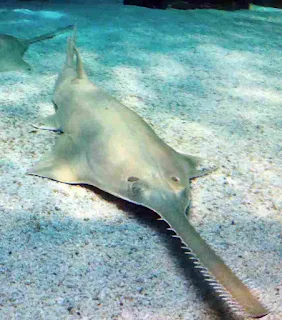Pristis: Sawfish
Classification:
Kingdom: Animalia
Phylum: Chordata
Class: Chondrichthyes
Order: Rhinopristiformes
Family: Pristidae
Bonaparte, 1838
Geographical distribution of Pristis
Pristis is reported from America, the Gulf of Mexico, Lower Mississippi, the Mediterranean Sea, and Atlantic waters. Upper Jurassic to Recent.
Habit and habitat of Pristis
Pristis is a warm water marine predacious fish feeding on small fishes and other marine animals by slashing them with its saw. It often ascends the river.
Comments on sawfish
(1) Commonly called saw-fish, weighing 150-500 kg and measuring 3 to 6 meters
(2) Elongated, the shark-like body is slightly depressed and divided into head, trunk, and tail.
(3) Body shape is midway between a shark and a ray. The anterior part is flattened dorsoventrally and is ray-like while the posterior part, for more than half, is shark-like. It exhibits a close relationship with rays.
(4) Head contains a pair of eyes and a pair of spiracles behind the eyes. Water passes through the spiracles and goes out through the gill slits.
(5) Snout is anteriorly produced into a saw-like rostrum with large and small weakly embedded teeth.
(6) Mouth ventral.
(7) Dorsal fins are large. The first dorsal fin is opposite the pelvic fin. The second dorsal fin is called the adipose fin. Paired fins are the pectoral fin and pelvic fin.
The tail contains heterocercal caudal fins Economic importance: The fish is also economically very beneficial as its liver oil is rich in vitamin value and its skin is used for making scale boards.
Special features of sawfish
(i) The important structure is the 'saw-like' snout, formed by the elongation and flattening of the head and skull. They are flattened in the form of a rostrum, which contains a series of tooth-like 16 to 32 pairs of teeth on the lateral margins. Teeth are fixed in sockets, in the calcified rostral cartilage. Rostrum acts as an organ of offense and defense. Pristis is capable of retaining urea in fresh water while ascending in rivers. Identification: Since this fish has a saw-like toothed snout and above features, hence it is Pristis.
1. Introduction to Pristis Sawfish: A Unique Aquatic Predator
Sawfish are a unique aquatic predator. The Pristis Sawfish, a remarkable aquatic predator, boasts a distinct appearance with its elongated, tooth-studded snout resembling a saw. Inhabiting warm coastal waters, these mesmerizing creatures employ their saw-like rostrum for hunting prey and defense. However, their survival is threatened by habitat loss and overfishing. Conservation efforts are vital to safeguard this unique species.
2. Anatomy and Physical Characteristics of Pristis Sawfish
The Pristis sawfish, a captivating aquatic creature, boasts a distinct anatomy. Its elongated snout is adorned with tooth-like projections, used for hunting and defense. With flattened bodies and unique fins, they navigate both freshwater and saltwater habitats. Sadly, these extraordinary animals are threatened by habitat loss and overfishing, necessitating urgent conservation efforts.
3. Habitat and Distribution of Pristis Sawfish Species
4. Feeding Behavior and Diet Patterns of Pristis Sawfish
The feeding behavior and diet patterns of Pristis sawfish offer intriguing insights into their role within aquatic ecosystems. These remarkable creatures, characterized by their distinctive elongated snouts lined with teeth, exhibit a unique hunting strategy. Sawfish primarily inhabit coastal and freshwater environments, where they employ their saw-like rostrums to detect and capture prey hidden in sediment or vegetation. Their diet is varied, encompassing small fish, crustaceans, and mollusks. By using their saws to stir up the substrate and locate prey, Pristis sawfish exemplify a specialized feeding adaptation that underscores their vital position in maintaining the balance of these aquatic habitats. Understanding their feeding behavior and dietary preferences is essential for conservation efforts aimed at protecting these enigmatic species and their ecosystems.
5. Reproduction and Life Cycle of Pristis Sawfish: A Fascinating Journey
The reproduction and life cycle of Pristis Sawfish presents a captivating odyssey. These majestic creatures employ internal fertilization, with females giving birth to live young. The pups begin their lives as miniature replicas of their parents, embarking on a remarkable journey of growth and survival, a testament to nature's wonder.
6. Conservation Status and Threats Faced by Pristis Sawfish Populations
The conservation status of Pristis sawfish populations is a cause for concern due to their declining numbers and vulnerability to various threats. These unique and ancient creatures, characterized by their long, flat snouts lined with teeth, are now classified as critically endangered by the International Union for Conservation of Nature (IUCN). Their populations have been severely impacted by habitat loss, overfishing, and accidental bycatch in fishing gear. Sawfish are slow to reproduce, making them particularly susceptible to these pressures. Efforts to safeguard their future involve a combination of habitat protection, fisheries management, and public awareness campaigns to reduce demand for their body parts. Collaborative actions are essential to ensure the survival of these remarkable sawfish species for generations to come.
7. Human Interactions: Cultural Significance and Historical Utilization of Pristis Sawfish
8. Ecological Importance: Pristis Sawfish's Role in Marine Ecosystems
The Pristis sawfish plays a vital ecological role in marine ecosystems as a keystone species. With its unique morphology and behavior, this majestic elasmobranch helps maintain the health and balance of coastal and estuarine environments. As a top predator, the sawfish helps control the population of prey species, preventing overgrazing and promoting biodiversity. Additionally, its foraging habits help aerate sediments, enhancing nutrient cycling and benefiting the overall health of the ecosystem. Furthermore, the sawfish's presence indicates the ecological integrity of its habitat, acting as an indicator species for environmental quality. The decline of Pristis sawfish populations due to human activities underscores the urgency of conservation efforts to preserve both their species and the intricate marine ecosystems they contribute to.
9. Research and Conservation Efforts: Safeguarding the Pristis Sawfish Species
10. Future Prospects: Challenges and Opportunities in Preserving Pristis Sawfish for Generations to Come


No comments:
Post a Comment